Organizational Behavior: Strategies for Advancing Female Participation
VerifiedAdded on 2021/06/16
|8
|2235
|56
Essay
AI Summary
This essay delves into the critical role of female participation in the workplace and its significance for economic growth and organizational success. It explores the factors driving increased female involvement, highlighting the complex interplay of economic, social, and educational elements. The paper identifies and analyzes key challenges such as the glass ceiling, gender wage gaps, gender segregation, and barriers to promotion that hinder women's advancement. Furthermore, it examines the impact of these challenges on female workers and the organization's overall performance. The essay then proposes various strategies to promote and enhance female participation, including organizational awareness, political navigation, mentoring, and supportive labor policies, emphasizing the importance of equal opportunities and a balanced work environment. The conclusion underscores the importance of addressing discrimination and inequality to foster a more inclusive and productive workplace, ultimately benefiting both individuals and the economy.
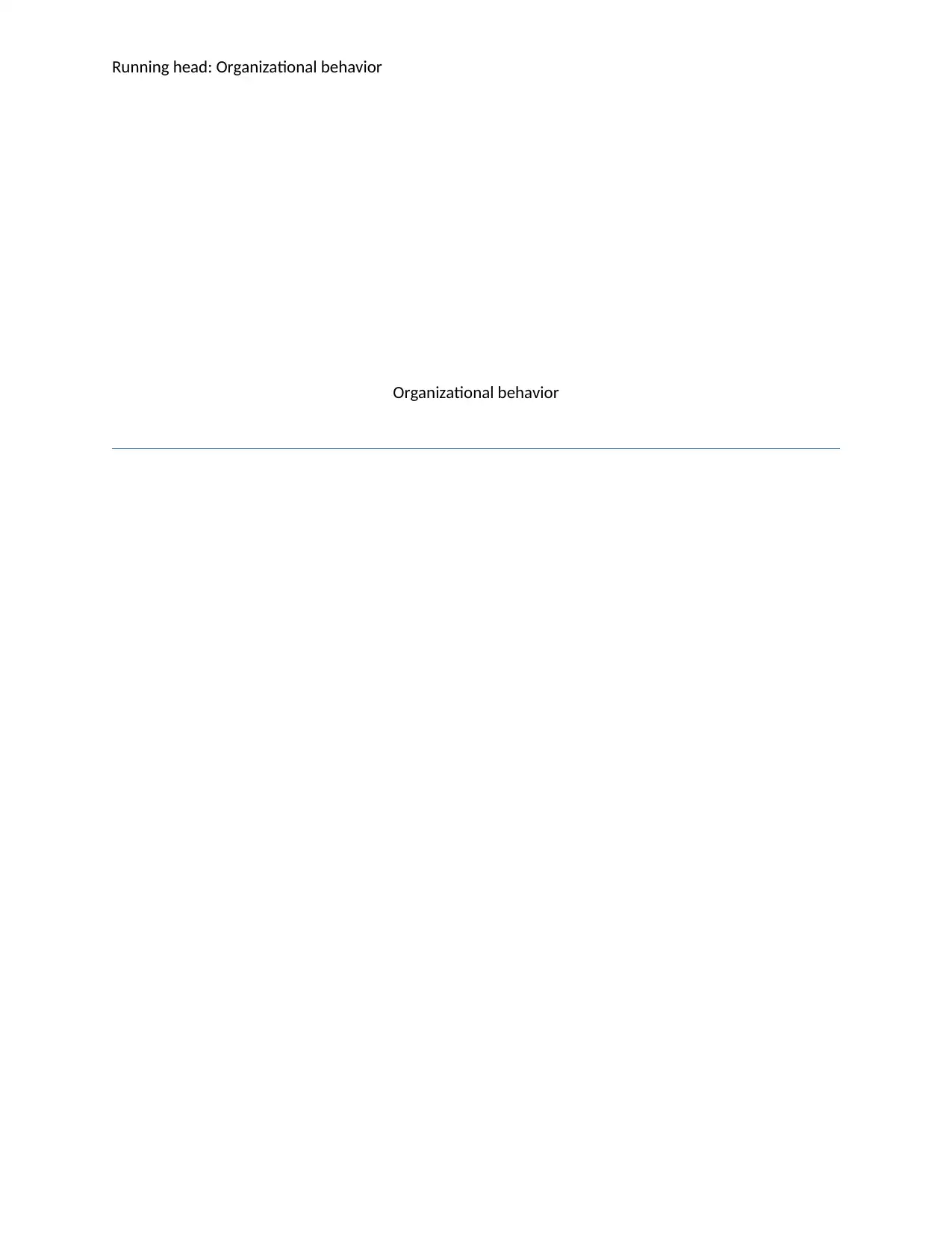
Running head: Organizational behavior
Organizational behavior
Organizational behavior
Paraphrase This Document
Need a fresh take? Get an instant paraphrase of this document with our AI Paraphraser
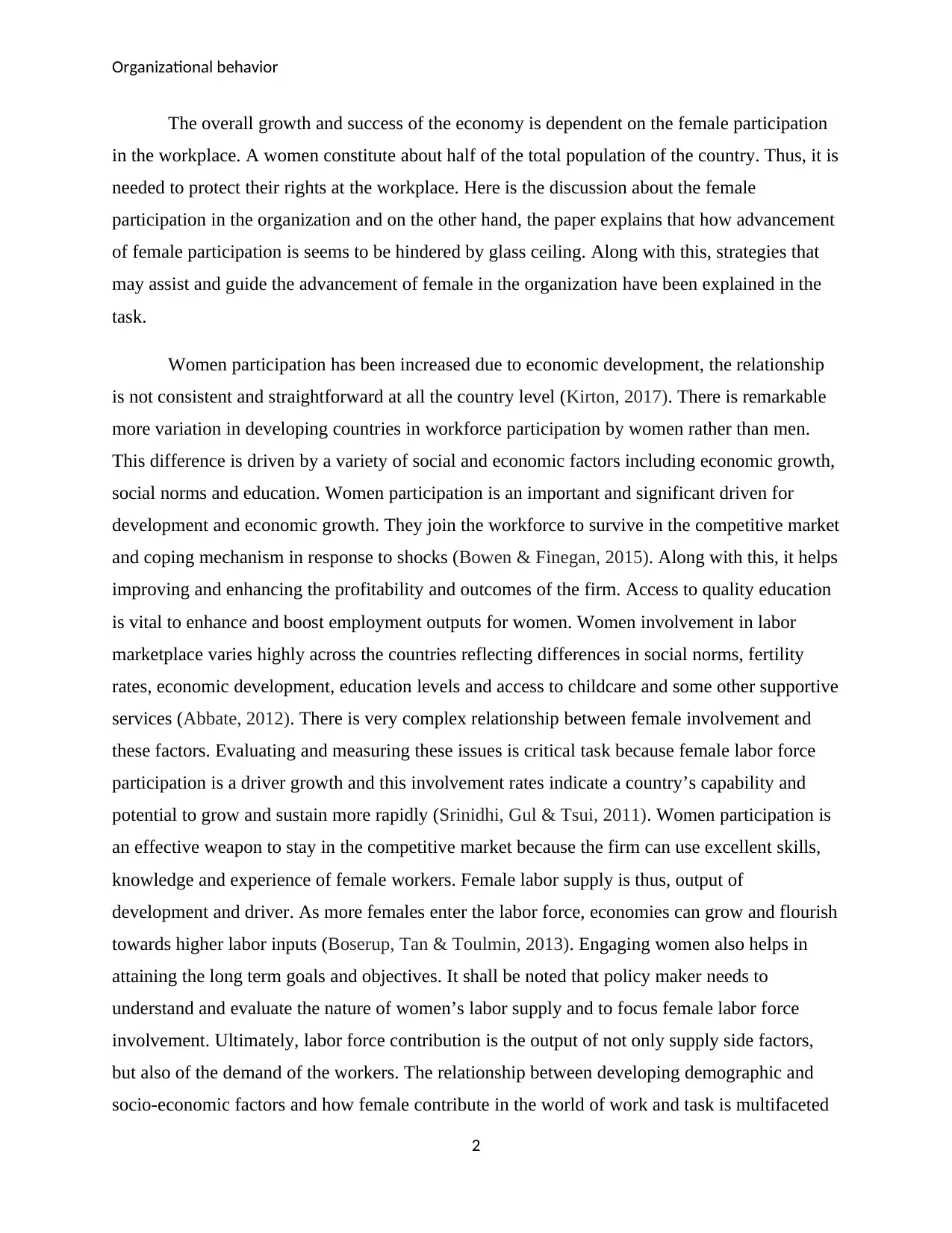
Organizational behavior
The overall growth and success of the economy is dependent on the female participation
in the workplace. A women constitute about half of the total population of the country. Thus, it is
needed to protect their rights at the workplace. Here is the discussion about the female
participation in the organization and on the other hand, the paper explains that how advancement
of female participation is seems to be hindered by glass ceiling. Along with this, strategies that
may assist and guide the advancement of female in the organization have been explained in the
task.
Women participation has been increased due to economic development, the relationship
is not consistent and straightforward at all the country level (Kirton, 2017). There is remarkable
more variation in developing countries in workforce participation by women rather than men.
This difference is driven by a variety of social and economic factors including economic growth,
social norms and education. Women participation is an important and significant driven for
development and economic growth. They join the workforce to survive in the competitive market
and coping mechanism in response to shocks (Bowen & Finegan, 2015). Along with this, it helps
improving and enhancing the profitability and outcomes of the firm. Access to quality education
is vital to enhance and boost employment outputs for women. Women involvement in labor
marketplace varies highly across the countries reflecting differences in social norms, fertility
rates, economic development, education levels and access to childcare and some other supportive
services (Abbate, 2012). There is very complex relationship between female involvement and
these factors. Evaluating and measuring these issues is critical task because female labor force
participation is a driver growth and this involvement rates indicate a country’s capability and
potential to grow and sustain more rapidly (Srinidhi, Gul & Tsui, 2011). Women participation is
an effective weapon to stay in the competitive market because the firm can use excellent skills,
knowledge and experience of female workers. Female labor supply is thus, output of
development and driver. As more females enter the labor force, economies can grow and flourish
towards higher labor inputs (Boserup, Tan & Toulmin, 2013). Engaging women also helps in
attaining the long term goals and objectives. It shall be noted that policy maker needs to
understand and evaluate the nature of women’s labor supply and to focus female labor force
involvement. Ultimately, labor force contribution is the output of not only supply side factors,
but also of the demand of the workers. The relationship between developing demographic and
socio-economic factors and how female contribute in the world of work and task is multifaceted
2
The overall growth and success of the economy is dependent on the female participation
in the workplace. A women constitute about half of the total population of the country. Thus, it is
needed to protect their rights at the workplace. Here is the discussion about the female
participation in the organization and on the other hand, the paper explains that how advancement
of female participation is seems to be hindered by glass ceiling. Along with this, strategies that
may assist and guide the advancement of female in the organization have been explained in the
task.
Women participation has been increased due to economic development, the relationship
is not consistent and straightforward at all the country level (Kirton, 2017). There is remarkable
more variation in developing countries in workforce participation by women rather than men.
This difference is driven by a variety of social and economic factors including economic growth,
social norms and education. Women participation is an important and significant driven for
development and economic growth. They join the workforce to survive in the competitive market
and coping mechanism in response to shocks (Bowen & Finegan, 2015). Along with this, it helps
improving and enhancing the profitability and outcomes of the firm. Access to quality education
is vital to enhance and boost employment outputs for women. Women involvement in labor
marketplace varies highly across the countries reflecting differences in social norms, fertility
rates, economic development, education levels and access to childcare and some other supportive
services (Abbate, 2012). There is very complex relationship between female involvement and
these factors. Evaluating and measuring these issues is critical task because female labor force
participation is a driver growth and this involvement rates indicate a country’s capability and
potential to grow and sustain more rapidly (Srinidhi, Gul & Tsui, 2011). Women participation is
an effective weapon to stay in the competitive market because the firm can use excellent skills,
knowledge and experience of female workers. Female labor supply is thus, output of
development and driver. As more females enter the labor force, economies can grow and flourish
towards higher labor inputs (Boserup, Tan & Toulmin, 2013). Engaging women also helps in
attaining the long term goals and objectives. It shall be noted that policy maker needs to
understand and evaluate the nature of women’s labor supply and to focus female labor force
involvement. Ultimately, labor force contribution is the output of not only supply side factors,
but also of the demand of the workers. The relationship between developing demographic and
socio-economic factors and how female contribute in the world of work and task is multifaceted
2
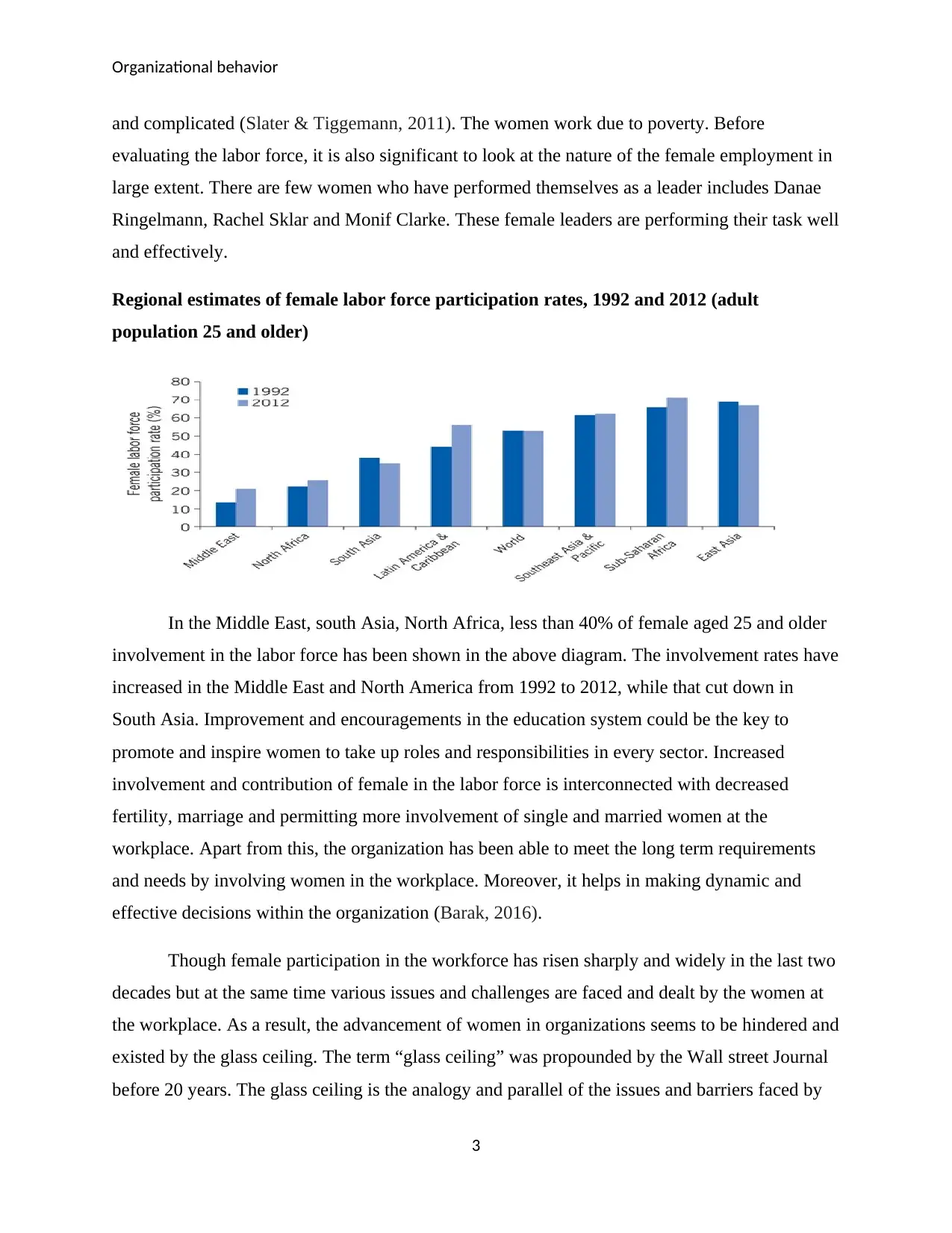
Organizational behavior
and complicated (Slater & Tiggemann, 2011). The women work due to poverty. Before
evaluating the labor force, it is also significant to look at the nature of the female employment in
large extent. There are few women who have performed themselves as a leader includes Danae
Ringelmann, Rachel Sklar and Monif Clarke. These female leaders are performing their task well
and effectively.
Regional estimates of female labor force participation rates, 1992 and 2012 (adult
population 25 and older)
In the Middle East, south Asia, North Africa, less than 40% of female aged 25 and older
involvement in the labor force has been shown in the above diagram. The involvement rates have
increased in the Middle East and North America from 1992 to 2012, while that cut down in
South Asia. Improvement and encouragements in the education system could be the key to
promote and inspire women to take up roles and responsibilities in every sector. Increased
involvement and contribution of female in the labor force is interconnected with decreased
fertility, marriage and permitting more involvement of single and married women at the
workplace. Apart from this, the organization has been able to meet the long term requirements
and needs by involving women in the workplace. Moreover, it helps in making dynamic and
effective decisions within the organization (Barak, 2016).
Though female participation in the workforce has risen sharply and widely in the last two
decades but at the same time various issues and challenges are faced and dealt by the women at
the workplace. As a result, the advancement of women in organizations seems to be hindered and
existed by the glass ceiling. The term “glass ceiling” was propounded by the Wall street Journal
before 20 years. The glass ceiling is the analogy and parallel of the issues and barriers faced by
3
and complicated (Slater & Tiggemann, 2011). The women work due to poverty. Before
evaluating the labor force, it is also significant to look at the nature of the female employment in
large extent. There are few women who have performed themselves as a leader includes Danae
Ringelmann, Rachel Sklar and Monif Clarke. These female leaders are performing their task well
and effectively.
Regional estimates of female labor force participation rates, 1992 and 2012 (adult
population 25 and older)
In the Middle East, south Asia, North Africa, less than 40% of female aged 25 and older
involvement in the labor force has been shown in the above diagram. The involvement rates have
increased in the Middle East and North America from 1992 to 2012, while that cut down in
South Asia. Improvement and encouragements in the education system could be the key to
promote and inspire women to take up roles and responsibilities in every sector. Increased
involvement and contribution of female in the labor force is interconnected with decreased
fertility, marriage and permitting more involvement of single and married women at the
workplace. Apart from this, the organization has been able to meet the long term requirements
and needs by involving women in the workplace. Moreover, it helps in making dynamic and
effective decisions within the organization (Barak, 2016).
Though female participation in the workforce has risen sharply and widely in the last two
decades but at the same time various issues and challenges are faced and dealt by the women at
the workplace. As a result, the advancement of women in organizations seems to be hindered and
existed by the glass ceiling. The term “glass ceiling” was propounded by the Wall street Journal
before 20 years. The glass ceiling is the analogy and parallel of the issues and barriers faced by
3
⊘ This is a preview!⊘
Do you want full access?
Subscribe today to unlock all pages.

Trusted by 1+ million students worldwide
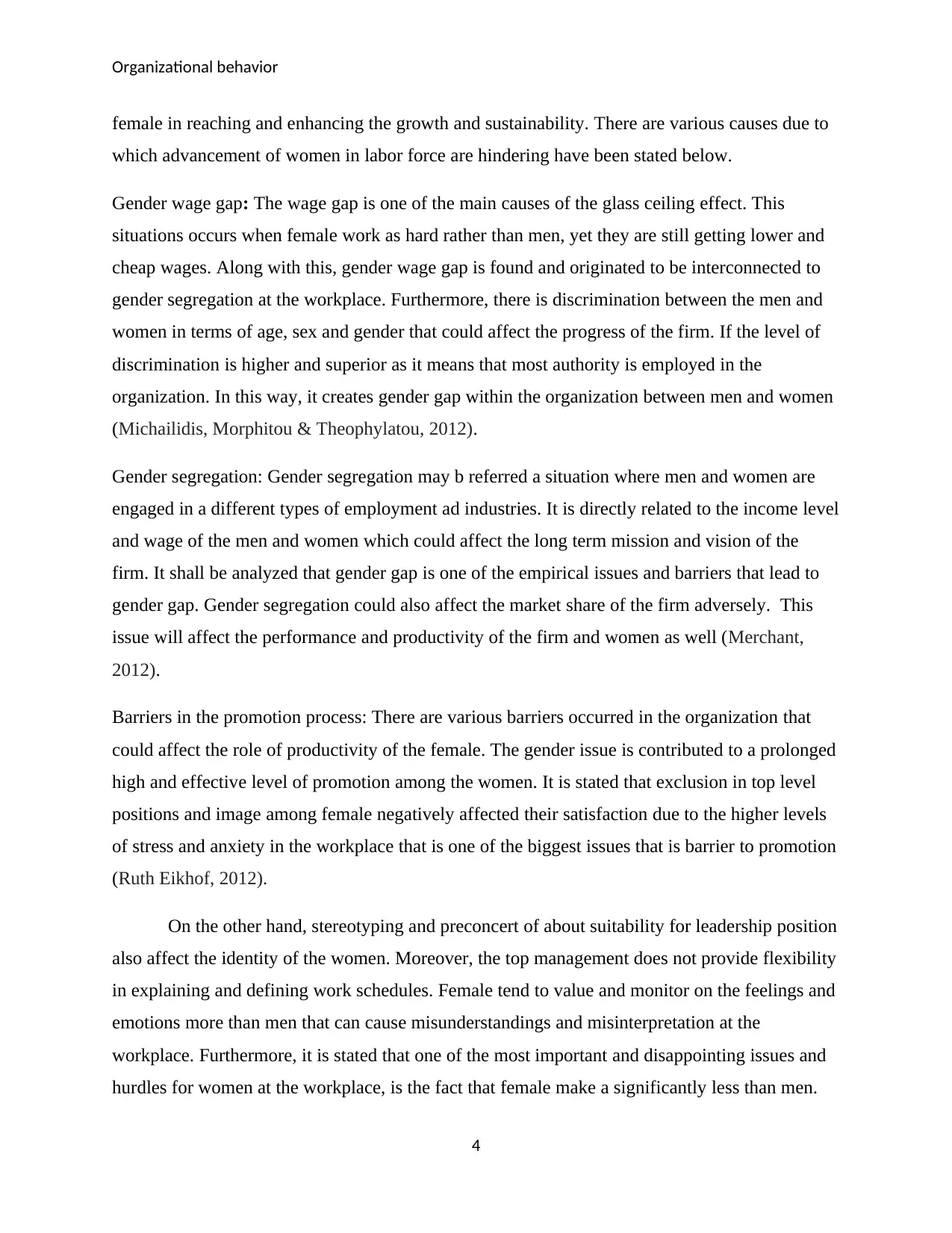
Organizational behavior
female in reaching and enhancing the growth and sustainability. There are various causes due to
which advancement of women in labor force are hindering have been stated below.
Gender wage gap: The wage gap is one of the main causes of the glass ceiling effect. This
situations occurs when female work as hard rather than men, yet they are still getting lower and
cheap wages. Along with this, gender wage gap is found and originated to be interconnected to
gender segregation at the workplace. Furthermore, there is discrimination between the men and
women in terms of age, sex and gender that could affect the progress of the firm. If the level of
discrimination is higher and superior as it means that most authority is employed in the
organization. In this way, it creates gender gap within the organization between men and women
(Michailidis, Morphitou & Theophylatou, 2012).
Gender segregation: Gender segregation may b referred a situation where men and women are
engaged in a different types of employment ad industries. It is directly related to the income level
and wage of the men and women which could affect the long term mission and vision of the
firm. It shall be analyzed that gender gap is one of the empirical issues and barriers that lead to
gender gap. Gender segregation could also affect the market share of the firm adversely. This
issue will affect the performance and productivity of the firm and women as well (Merchant,
2012).
Barriers in the promotion process: There are various barriers occurred in the organization that
could affect the role of productivity of the female. The gender issue is contributed to a prolonged
high and effective level of promotion among the women. It is stated that exclusion in top level
positions and image among female negatively affected their satisfaction due to the higher levels
of stress and anxiety in the workplace that is one of the biggest issues that is barrier to promotion
(Ruth Eikhof, 2012).
On the other hand, stereotyping and preconcert of about suitability for leadership position
also affect the identity of the women. Moreover, the top management does not provide flexibility
in explaining and defining work schedules. Female tend to value and monitor on the feelings and
emotions more than men that can cause misunderstandings and misinterpretation at the
workplace. Furthermore, it is stated that one of the most important and disappointing issues and
hurdles for women at the workplace, is the fact that female make a significantly less than men.
4
female in reaching and enhancing the growth and sustainability. There are various causes due to
which advancement of women in labor force are hindering have been stated below.
Gender wage gap: The wage gap is one of the main causes of the glass ceiling effect. This
situations occurs when female work as hard rather than men, yet they are still getting lower and
cheap wages. Along with this, gender wage gap is found and originated to be interconnected to
gender segregation at the workplace. Furthermore, there is discrimination between the men and
women in terms of age, sex and gender that could affect the progress of the firm. If the level of
discrimination is higher and superior as it means that most authority is employed in the
organization. In this way, it creates gender gap within the organization between men and women
(Michailidis, Morphitou & Theophylatou, 2012).
Gender segregation: Gender segregation may b referred a situation where men and women are
engaged in a different types of employment ad industries. It is directly related to the income level
and wage of the men and women which could affect the long term mission and vision of the
firm. It shall be analyzed that gender gap is one of the empirical issues and barriers that lead to
gender gap. Gender segregation could also affect the market share of the firm adversely. This
issue will affect the performance and productivity of the firm and women as well (Merchant,
2012).
Barriers in the promotion process: There are various barriers occurred in the organization that
could affect the role of productivity of the female. The gender issue is contributed to a prolonged
high and effective level of promotion among the women. It is stated that exclusion in top level
positions and image among female negatively affected their satisfaction due to the higher levels
of stress and anxiety in the workplace that is one of the biggest issues that is barrier to promotion
(Ruth Eikhof, 2012).
On the other hand, stereotyping and preconcert of about suitability for leadership position
also affect the identity of the women. Moreover, the top management does not provide flexibility
in explaining and defining work schedules. Female tend to value and monitor on the feelings and
emotions more than men that can cause misunderstandings and misinterpretation at the
workplace. Furthermore, it is stated that one of the most important and disappointing issues and
hurdles for women at the workplace, is the fact that female make a significantly less than men.
4
Paraphrase This Document
Need a fresh take? Get an instant paraphrase of this document with our AI Paraphraser
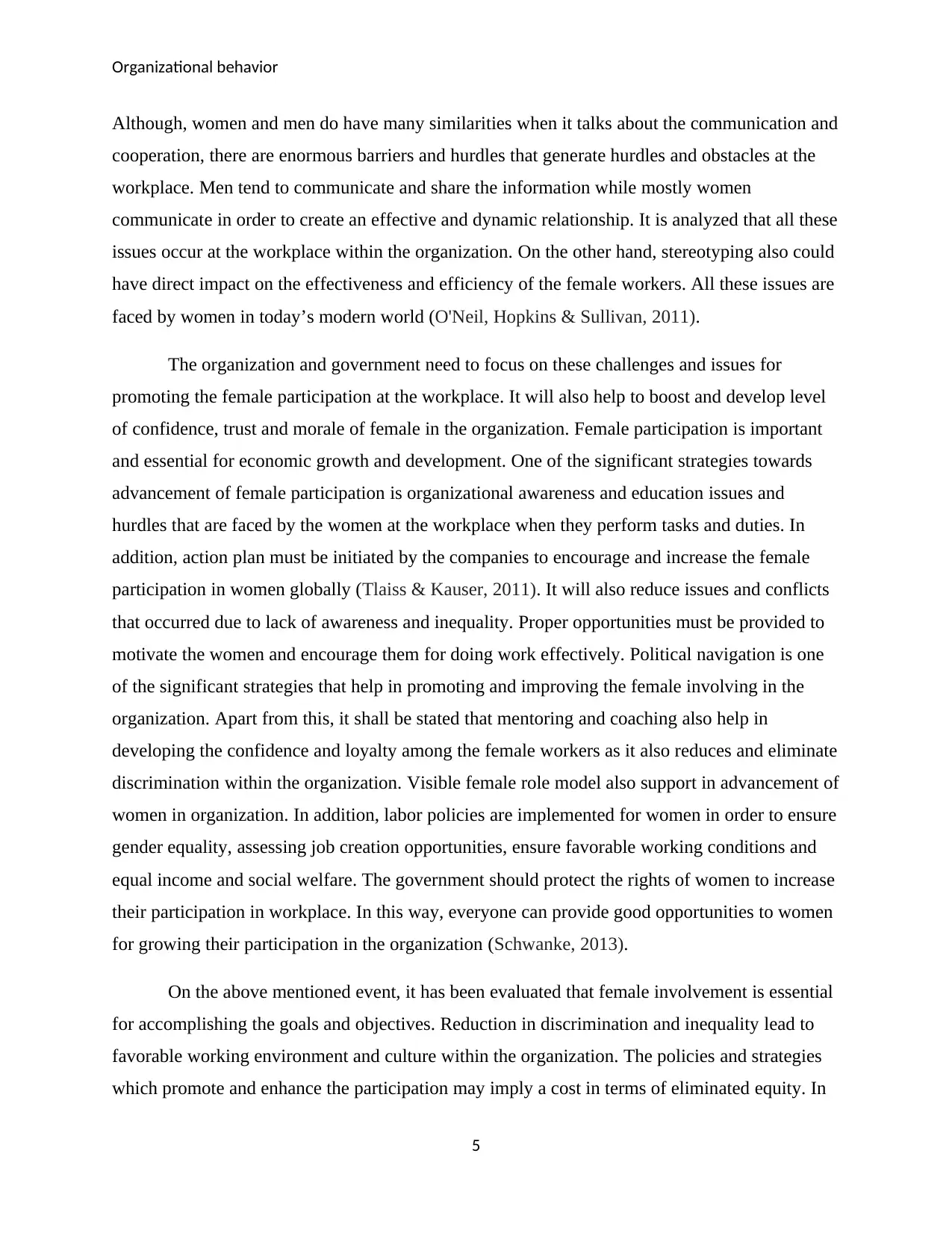
Organizational behavior
Although, women and men do have many similarities when it talks about the communication and
cooperation, there are enormous barriers and hurdles that generate hurdles and obstacles at the
workplace. Men tend to communicate and share the information while mostly women
communicate in order to create an effective and dynamic relationship. It is analyzed that all these
issues occur at the workplace within the organization. On the other hand, stereotyping also could
have direct impact on the effectiveness and efficiency of the female workers. All these issues are
faced by women in today’s modern world (O'Neil, Hopkins & Sullivan, 2011).
The organization and government need to focus on these challenges and issues for
promoting the female participation at the workplace. It will also help to boost and develop level
of confidence, trust and morale of female in the organization. Female participation is important
and essential for economic growth and development. One of the significant strategies towards
advancement of female participation is organizational awareness and education issues and
hurdles that are faced by the women at the workplace when they perform tasks and duties. In
addition, action plan must be initiated by the companies to encourage and increase the female
participation in women globally (Tlaiss & Kauser, 2011). It will also reduce issues and conflicts
that occurred due to lack of awareness and inequality. Proper opportunities must be provided to
motivate the women and encourage them for doing work effectively. Political navigation is one
of the significant strategies that help in promoting and improving the female involving in the
organization. Apart from this, it shall be stated that mentoring and coaching also help in
developing the confidence and loyalty among the female workers as it also reduces and eliminate
discrimination within the organization. Visible female role model also support in advancement of
women in organization. In addition, labor policies are implemented for women in order to ensure
gender equality, assessing job creation opportunities, ensure favorable working conditions and
equal income and social welfare. The government should protect the rights of women to increase
their participation in workplace. In this way, everyone can provide good opportunities to women
for growing their participation in the organization (Schwanke, 2013).
On the above mentioned event, it has been evaluated that female involvement is essential
for accomplishing the goals and objectives. Reduction in discrimination and inequality lead to
favorable working environment and culture within the organization. The policies and strategies
which promote and enhance the participation may imply a cost in terms of eliminated equity. In
5
Although, women and men do have many similarities when it talks about the communication and
cooperation, there are enormous barriers and hurdles that generate hurdles and obstacles at the
workplace. Men tend to communicate and share the information while mostly women
communicate in order to create an effective and dynamic relationship. It is analyzed that all these
issues occur at the workplace within the organization. On the other hand, stereotyping also could
have direct impact on the effectiveness and efficiency of the female workers. All these issues are
faced by women in today’s modern world (O'Neil, Hopkins & Sullivan, 2011).
The organization and government need to focus on these challenges and issues for
promoting the female participation at the workplace. It will also help to boost and develop level
of confidence, trust and morale of female in the organization. Female participation is important
and essential for economic growth and development. One of the significant strategies towards
advancement of female participation is organizational awareness and education issues and
hurdles that are faced by the women at the workplace when they perform tasks and duties. In
addition, action plan must be initiated by the companies to encourage and increase the female
participation in women globally (Tlaiss & Kauser, 2011). It will also reduce issues and conflicts
that occurred due to lack of awareness and inequality. Proper opportunities must be provided to
motivate the women and encourage them for doing work effectively. Political navigation is one
of the significant strategies that help in promoting and improving the female involving in the
organization. Apart from this, it shall be stated that mentoring and coaching also help in
developing the confidence and loyalty among the female workers as it also reduces and eliminate
discrimination within the organization. Visible female role model also support in advancement of
women in organization. In addition, labor policies are implemented for women in order to ensure
gender equality, assessing job creation opportunities, ensure favorable working conditions and
equal income and social welfare. The government should protect the rights of women to increase
their participation in workplace. In this way, everyone can provide good opportunities to women
for growing their participation in the organization (Schwanke, 2013).
On the above mentioned event, it has been evaluated that female involvement is essential
for accomplishing the goals and objectives. Reduction in discrimination and inequality lead to
favorable working environment and culture within the organization. The policies and strategies
which promote and enhance the participation may imply a cost in terms of eliminated equity. In
5
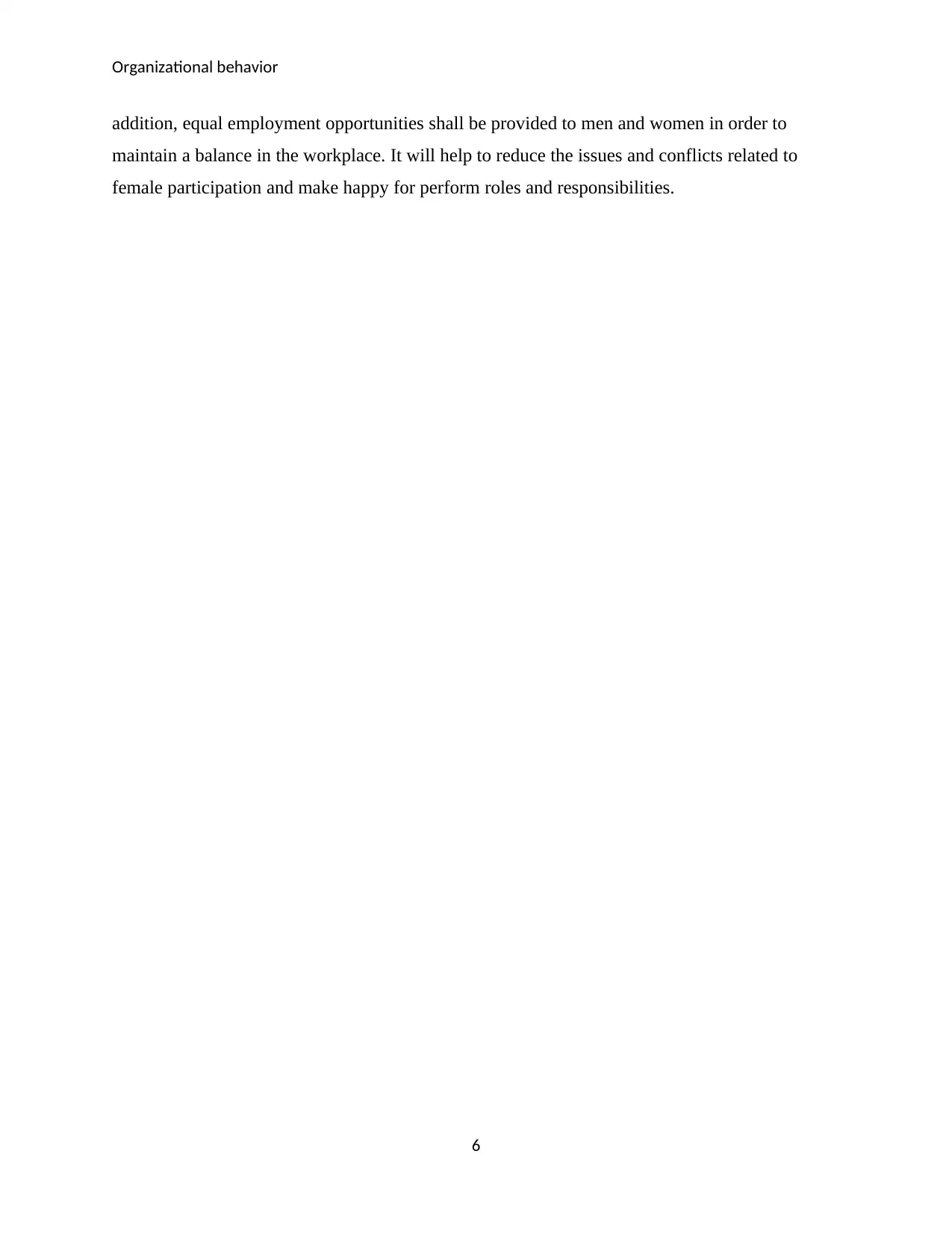
Organizational behavior
addition, equal employment opportunities shall be provided to men and women in order to
maintain a balance in the workplace. It will help to reduce the issues and conflicts related to
female participation and make happy for perform roles and responsibilities.
6
addition, equal employment opportunities shall be provided to men and women in order to
maintain a balance in the workplace. It will help to reduce the issues and conflicts related to
female participation and make happy for perform roles and responsibilities.
6
⊘ This is a preview!⊘
Do you want full access?
Subscribe today to unlock all pages.

Trusted by 1+ million students worldwide
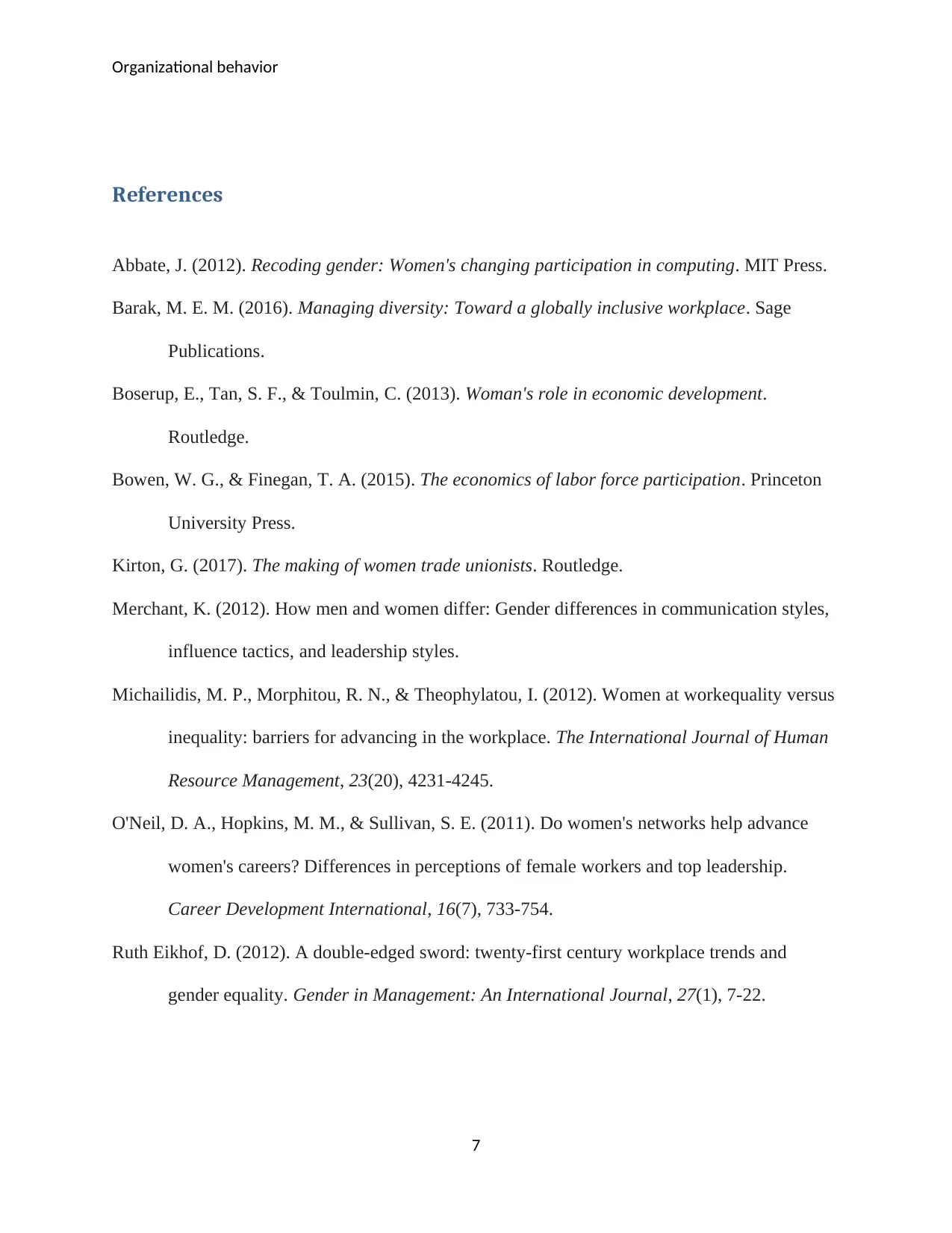
Organizational behavior
References
Abbate, J. (2012). Recoding gender: Women's changing participation in computing. MIT Press.
Barak, M. E. M. (2016). Managing diversity: Toward a globally inclusive workplace. Sage
Publications.
Boserup, E., Tan, S. F., & Toulmin, C. (2013). Woman's role in economic development.
Routledge.
Bowen, W. G., & Finegan, T. A. (2015). The economics of labor force participation. Princeton
University Press.
Kirton, G. (2017). The making of women trade unionists. Routledge.
Merchant, K. (2012). How men and women differ: Gender differences in communication styles,
influence tactics, and leadership styles.
Michailidis, M. P., Morphitou, R. N., & Theophylatou, I. (2012). Women at workequality versus
inequality: barriers for advancing in the workplace. The International Journal of Human
Resource Management, 23(20), 4231-4245.
O'Neil, D. A., Hopkins, M. M., & Sullivan, S. E. (2011). Do women's networks help advance
women's careers? Differences in perceptions of female workers and top leadership.
Career Development International, 16(7), 733-754.
Ruth Eikhof, D. (2012). A double-edged sword: twenty-first century workplace trends and
gender equality. Gender in Management: An International Journal, 27(1), 7-22.
7
References
Abbate, J. (2012). Recoding gender: Women's changing participation in computing. MIT Press.
Barak, M. E. M. (2016). Managing diversity: Toward a globally inclusive workplace. Sage
Publications.
Boserup, E., Tan, S. F., & Toulmin, C. (2013). Woman's role in economic development.
Routledge.
Bowen, W. G., & Finegan, T. A. (2015). The economics of labor force participation. Princeton
University Press.
Kirton, G. (2017). The making of women trade unionists. Routledge.
Merchant, K. (2012). How men and women differ: Gender differences in communication styles,
influence tactics, and leadership styles.
Michailidis, M. P., Morphitou, R. N., & Theophylatou, I. (2012). Women at workequality versus
inequality: barriers for advancing in the workplace. The International Journal of Human
Resource Management, 23(20), 4231-4245.
O'Neil, D. A., Hopkins, M. M., & Sullivan, S. E. (2011). Do women's networks help advance
women's careers? Differences in perceptions of female workers and top leadership.
Career Development International, 16(7), 733-754.
Ruth Eikhof, D. (2012). A double-edged sword: twenty-first century workplace trends and
gender equality. Gender in Management: An International Journal, 27(1), 7-22.
7
Paraphrase This Document
Need a fresh take? Get an instant paraphrase of this document with our AI Paraphraser
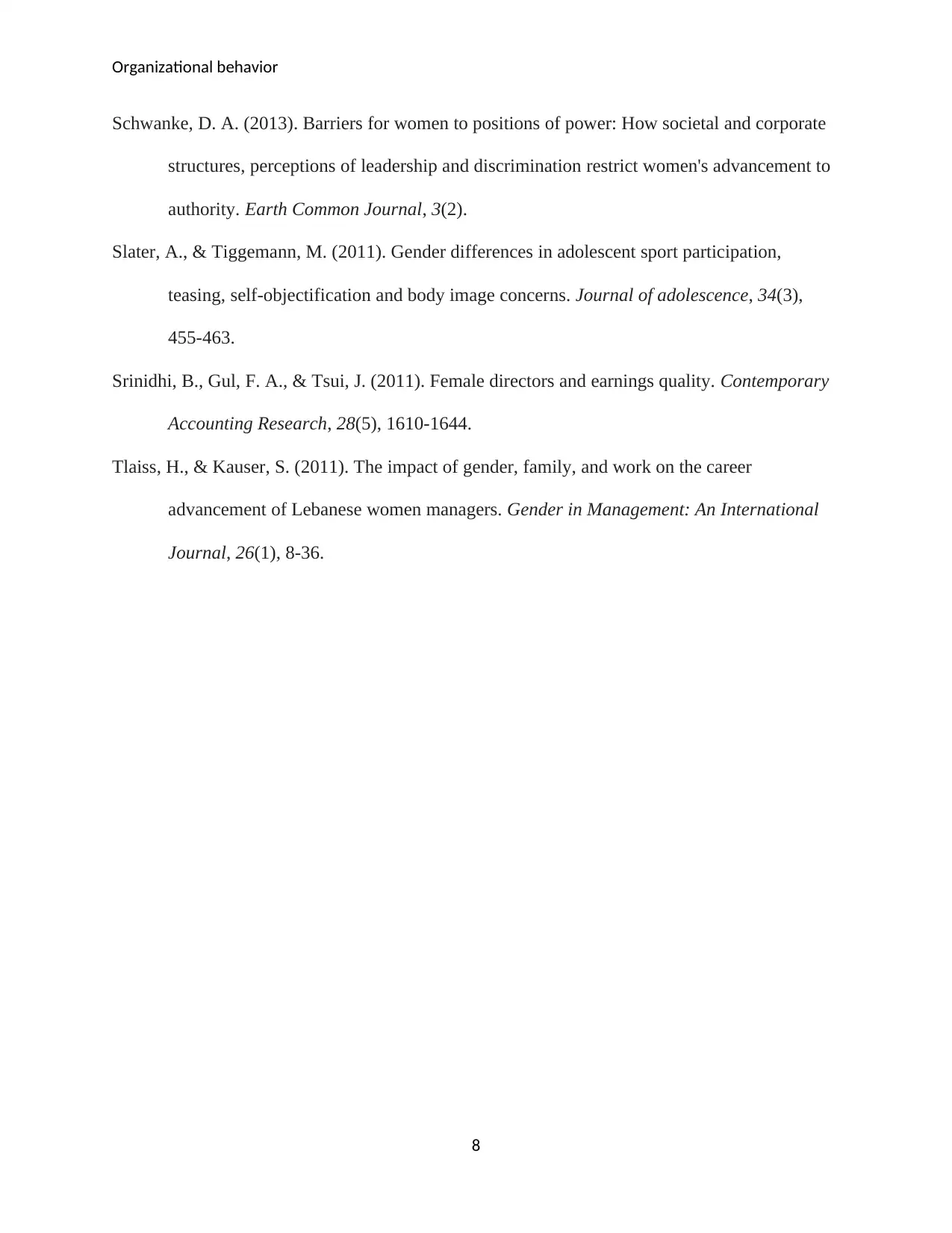
Organizational behavior
Schwanke, D. A. (2013). Barriers for women to positions of power: How societal and corporate
structures, perceptions of leadership and discrimination restrict women's advancement to
authority. Earth Common Journal, 3(2).
Slater, A., & Tiggemann, M. (2011). Gender differences in adolescent sport participation,
teasing, self-objectification and body image concerns. Journal of adolescence, 34(3),
455-463.
Srinidhi, B., Gul, F. A., & Tsui, J. (2011). Female directors and earnings quality. Contemporary
Accounting Research, 28(5), 1610-1644.
Tlaiss, H., & Kauser, S. (2011). The impact of gender, family, and work on the career
advancement of Lebanese women managers. Gender in Management: An International
Journal, 26(1), 8-36.
8
Schwanke, D. A. (2013). Barriers for women to positions of power: How societal and corporate
structures, perceptions of leadership and discrimination restrict women's advancement to
authority. Earth Common Journal, 3(2).
Slater, A., & Tiggemann, M. (2011). Gender differences in adolescent sport participation,
teasing, self-objectification and body image concerns. Journal of adolescence, 34(3),
455-463.
Srinidhi, B., Gul, F. A., & Tsui, J. (2011). Female directors and earnings quality. Contemporary
Accounting Research, 28(5), 1610-1644.
Tlaiss, H., & Kauser, S. (2011). The impact of gender, family, and work on the career
advancement of Lebanese women managers. Gender in Management: An International
Journal, 26(1), 8-36.
8
1 out of 8
Related Documents
Your All-in-One AI-Powered Toolkit for Academic Success.
+13062052269
info@desklib.com
Available 24*7 on WhatsApp / Email
![[object Object]](/_next/static/media/star-bottom.7253800d.svg)
Unlock your academic potential
Copyright © 2020–2025 A2Z Services. All Rights Reserved. Developed and managed by ZUCOL.





